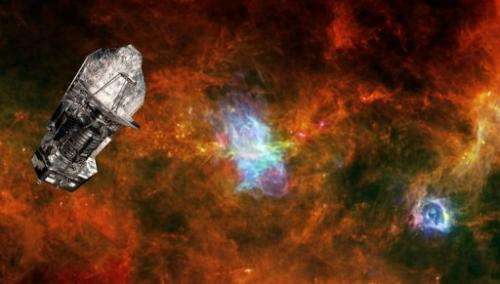Herschel telescope bows out after successful mission

Europe's deep-space Herschel telescope has given up the ghost—running out of coolant after a successful mission to observe the birth of stars and galaxies, the European Space Agency said Monday.
"Herschel has made over 35,000 scientific observations, amassing more than 25,000 hours' worth of science data from about 600 observing programmes," it said in a eulogy.
"The archive will become the legacy of the mission. It is expected to provide even more discoveries than have been made during the lifetime of the Herschel mission."
Launched in May 2009, Herschel carried 2,300 litres of liquid helium coolant, which has been slowly evaporating.
Herschel became the largest and most powerful infrared telescope in space. Its expected lifetime was 3.5 years.
The helium was used to cool the satellite's instruments to near absolute zero (minus 273.15 degrees Celsius or minus 459.67 degrees Fahrenheit) to enable it to make its observations.
At 7.5 metres (24.3 feet) high and four metres (13 feet) wide, Herschel had a launch mass of 3.4 tonnes.
It cost 1.1 billion euros ($1.4 billion).
It was named after Sir William Herschel, the German-born British astronomer who discovered Uranus in 1781 and infrared radiation in 1800.
It carried three cameras and spectrometers and a primary mirror 3.5 metres (11.37 feet) across—able to collect almost 20 times more light than any previous infrared space telescope.
Its infrared technology allowed Herschel to see galaxies that were previously hidden from scientists' view by cosmic dust clouds.
In 2011, it was reported that Herschel found the first confirmed evidence of oxygen molecules in space.
"Herschel has offered us a new view of the hitherto hidden Universe, pointing us to a previously unseen process of star birth and galaxy formation, and allowing us to trace water through the Universe from molecular clouds to newborn stars and their planet-forming discs and belts of comets," said Goran Pilbratt, ESA Herschel Project Scientist.
The telescope will still be able to communicate with its ground stations for some time, placed in a "parking orbit" around the Sun.
© 2013 AFP


















